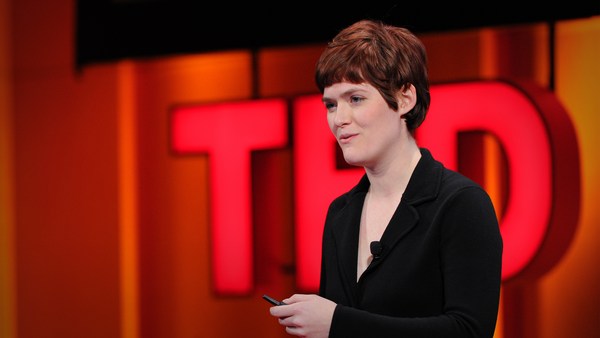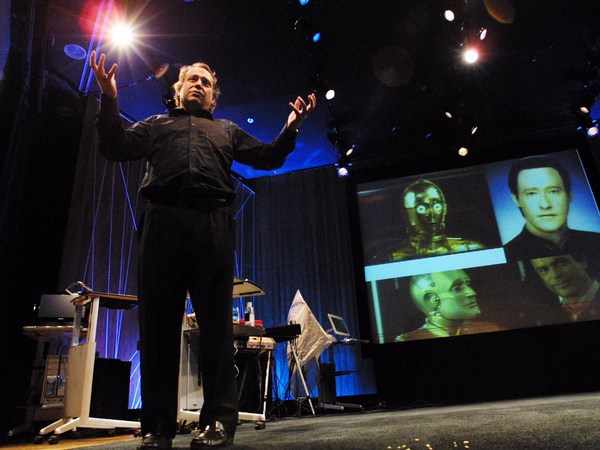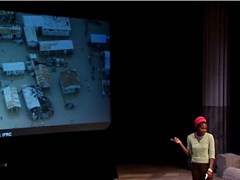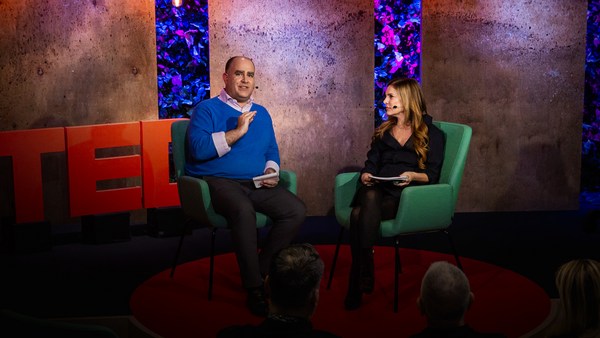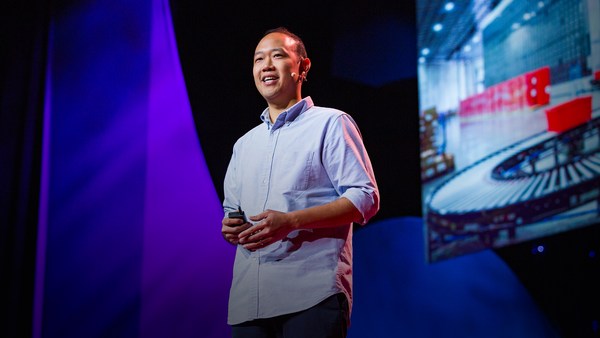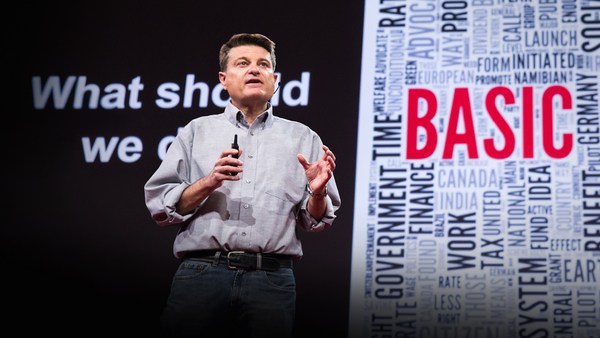I want to talk to you about, or share with you, a breakthrough new approach for managing items of inventory inside of a warehouse. We're talking about a pick, pack and ship setting here.
So as a hint, this solution involves hundreds of mobile robots, sometimes thousands of mobile robots, moving around a warehouse. And I'll get to the solution. But for a moment, just think about the last time that you ordered something online. You were sitting on your couch and you decided that you absolutely had to have this red t-shirt. So — click! — you put it into your shopping cart. And then you decided that green pair of pants looks pretty good too — click! And maybe a blue pair of shoes — click! So at this point you've assembled your order. You didn't stop to think for a moment that that might not be a great outfit. But you hit "submit order." And two days later, this package shows up on your doorstep. And you open the box and you're like, wow, there's my goo.
Did you ever stop to think about how those items of inventory actually found their way inside that box in the warehouse? So I'm here to tell you it's that guy right there. So deep in the middle of that picture, you see a classic pick-pack worker in a distribution or order fulfillments setting. Classically these pick workers will spend 60 or 70 percent of their day wandering around the warehouse. They'll often walk as much as 5 or 10 miles in pursuit of those items of inventory. Not only is this an unproductive way to fill orders, it also turns out to be an unfulfilling way to fill orders.
So let me tell you where I first bumped into this problem. I was out in the Bay area in '99, 2000, the dot com boom. I worked for a fabulously spectacular flame-out called Webvan. (Laughter) This company raised hundreds of millions of dollars with the notion that we will deliver grocery orders online. And it really came down to the fact that we couldn't do it cost effectively. Turns out e-commerce was something that was very hard and very costly. In this particular instance we were trying to assemble 30 items of inventory into a few totes, onto a van to deliver to the home. And when you think about it, it was costing us 30 dollars. Imagine, we had an 89¢ can of soup that was costing us one dollar to pick and pack into that tote. And that's before we actually tried to deliver it to the home.
So long story short, during my one year at Webvan, what I realized by talking to all the material-handling providers was that there was no solution designed specifically to solve each base picking. Red item, green, blue, getting those three things in a box. So we said, there's just got to be a better way to do this. Existing material handling was set up to pump pallets and cases of goo to retail stores.
Of course Webvan went out of business, and about a year and a half later, I was still noodling on this problem. It was still nagging at me. And I started thinking about it again. And I said, let me just focus briefly on what I wanted as a pick worker, or my vision for how it should work. (Laughter) I said, let's focus on the problem. I have an order here and what I want to do is I want to put red, green and blue in this box right here. What I need is a system where I put out my hand and — poof! — the product shows up and I pack it into the order, and now we're thinking, this would be a very operator-centric approach to solving the problem. This is what I need. What technology is available to solve this problem? But as you can see, orders can come and go, products can come and go. It allows us to focus on making the pick worker the center of the problem, and providing them the tools to make them as productive as possible.
So how did I arrive at this notion? Well, actually it came from a brainstorming exercise, probably a technique that many of you use, It's this notion of testing your ideas. Take a blank sheet, of course, but then test your ideas at the limits — infinity, zero. In this particular case, we challenged ourselves with the idea: What if we had to build a distribution center in China, where it's a very, very low-cost market? And say, labor is cheap, land is cheap. And we said specifically, "What if it was zero dollars an hour for direct labor and we could build a million- square-foot distribution center?" So naturally that led to ideas that said, "Let's put lots of people in the warehouse." And I said, "Hold on, zero dollars per hour, what I would do is 'hire' 10,000 workers to come to the warehouse every morning at 8 a.m., walk into the warehouse and pick up one item of inventory and then just stand there. So you hold Captain Crunch, you hold the Mountain Dew, you hold the Diet Coke. If I need it, I'll call you, otherwise just stand there. But when I need Diet Coke and I call it, you guys talk amongst yourselves. Diet Coke walks up to the front — pick it, put it in the tote, away it goes." Wow, what if the products could walk and talk on their own? That's a very interesting, very powerful way that we could potentially organize this warehouse.
So of course, labor isn't free, on that practical versus awesome spectrum. (Laughter) So we said mobile shelving — We'll put them on mobile shelving. We'll use mobile robots and we'll move the inventory around. And so we got underway on that and then I'm sitting on my couch in 2008. Did any of you see the Beijing Olympics, the opening ceremonies? I about fell out of my couch when I saw this. I'm like, that was the idea! (Laughter and Applause) We'll put thousands of people on the warehouse floor, the stadium floor. But interestingly enough, this actually relates to the idea in that these guys were creating some incredibly powerful, impressive digital art, all without computers, I'm told, it was all peer-to-peer coordination and communication. You stand up, I'll squat down. And they made some fabulous art. It speaks to the power of emergence in systems when you let things start to talk with each other. So that was a little bit of the journey.
So of course, now what became the practical reality of this idea? Here is a warehouse. It's a pick, pack and ship center that has about 10,000 different SKUs. We'll call them red pens, green pens, yellow Post-It Notes. We send the little orange robots out to pick up the blue shelving pods. And we deliver them to the side of the building. So all the pick workers now get to stay on the perimeter. And the game here is to pick up the shelves, take them down the highway and deliver them straight to the pick worker. This pick worker's life is completely different. Rather than wandering around the warehouse, she gets to stay still in a pick station like this and every product in the building can now come to her.
So the process is very productive. Reach in, pick an item, scan the bar code, pack it out. By the time you turn around, there's another product there ready to be picked and packed. So what we've done is take out all of the non-value added walking, searching, wasting, waited time, and we've developed a very high-fidelity way to pick these orders, where you point at it with a laser, scan the UPC barcode, and then indicate with a light which box it needs to go into. So more productive, more accurate and, it turns out, it's a more interesting office environment for these pick workers. They actually complete the whole order. So they do red, green and blue, not just a part of the order. And they feel a little bit more in control of their environment.
So the side effects of this approach are what really surprised us. We knew it was going to be more productive. But we didn't realize just how pervasive this way of thinking extended to other functions in the warehouse. But what effectively this approach is doing inside of the DC is turning it into a massively parallel processing engine. So this is again a cross-fertilization of ideas. Here's a warehouse and we're thinking about parallel processing supercomputer architectures. The notion here is that you have 10 workers on the right side of the screen that are now all independent autonomous pick workers. If the worker in station three decides to leave and go to the bathroom, it has no impact on the productivity of the other nine workers. Contrast that, for a moment, with the traditional method of using a conveyor. When one person passes the order to you, you put something in and pass it downstream. Everyone has to be in place for that serial process to work. This becomes a more robust way to think about the warehouse.
And then underneath the hoods gets interesting in that we're tracking the popularity of the products. And we're using dynamic and adaptive algorithms to tune the floor of the warehouse. So what you see here potentially the week leading up to Valentine's Day. All that pink chalky candy has moved to the front of the building and is now being picked into a lot of orders in those pick stations. Come in two days after Valentine's Day, and that candy, the leftover candy, has all drifted to the back of the warehouse and is occupying the cooler zone on the thermal map there. One other side effect of this approach using the parallel processing is these things can scale to ginormous. (Laughter) So whether you're doing two pick stations, 20 pick stations, or 200 pick stations, the path planning algorithms and all of the inventory algorithms just work. In this example you see that the inventory has now occupied all the perimeter of the building because that's where the pick stations were. They sorted it out for themselves.
So I'll conclude with just one final video that shows how this comes to bear on the pick worker's actual day in the life of. So as we mentioned, the process is to move inventory along the highway and then find your way into these pick stations. And our software in the background understands what's going on in each station, we direct the pods across the highway and we're attempting to get into a queuing system to present the work to the pick worker. What's interesting is we can even adapt the speed of the pick workers. The faster pickers get more pods and the slower pickers get few. But this pick worker now is literally having that experience that we described before. She puts out her hand. The product jumps into it. Or she has to reach in and get it. She scans it and she puts it in the bucket. And all of the rest of the technology is kind of behind the scenes. So she gets to now focus on the picking and packing portion of her job. Never has any idle time, never has to leave her mat. And actually we think not only a more productive and more accurate way to fill orders. We think it's a more fulfilling way to fill orders.
The reason we can say that, though, is that workers in a lot of these buildings now compete for the privilege of working in the Kiva zone that day. And sometimes we'll catch them on testimonial videos saying such things as, they have more energy after the day to play with their grandchildren, or in one case a guy said, "the Kiva zone is so stress-free that I've actually stopped taking my blood pressure medication." (Laughter) That was at a pharmaceutical distributor, so they told us not to use that video. (Laughter)
So what I wanted to leave you with today is the notion that when you let things start to think and walk and talk on their own, interesting processes and productivities can emerge. And now I think next time you go to your front step and pick up that box that you just ordered online, you break it open and the goo is in there, you'll have some wonderment as to whether a robot assisted in the picking and packing of that order.
Thank you. (Applause)
